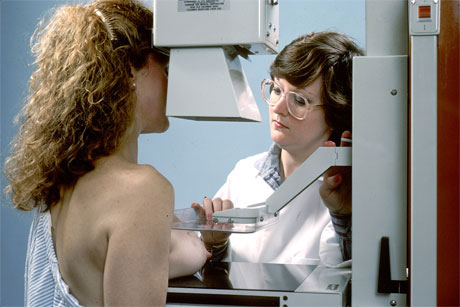Experts On Mammograms And Breast Cancer
Source: rense.com

Picked up from: davidicke.com
Regular mammography of younger women increases their cancer risks. Analysis of controlled trials over the last decade has shown consistent increases in breast cancer mortality within a few years of commencing screening. This confirms evidence of the high sensitivity of the premenopausal breast, and on cumulative carcinogenic effects of radiation.
The Politics Of Cancer by Samuel S Epstein MD, page 539
In his book, "Preventing Breast Cancer," Dr. Gofinan says that breast cancer is the leading cause of death among American women between the ages of forty-four and fifty-five. Because breast tissue is highly radiation-sensitive, mammograms can cause cancer. The danger can be heightened by a woman's genetic makeup, preexisting benign breast disease, artificial menopause, obesity, and hormonal imbalance.
Death By Medicine by Gary Null PhD, page 23
"The risk of radiation-induced breast cancer has long been a concern to mammographers and has driven the efforts to minimize radiation dose per examination," the panel explained. "Radiation can cause breast cancer in women, and the risk is proportional to dose. The younger the woman at the time of exposure, the greater her lifetime risk for breast cancer.
Under The Influence Modern Medicine by Terry A Rondberg DC, page 122
Furthermore, there is clear evidence that the breast, particularly in premenopausal women, is highly sensitive to radiation, with estimates of increased risk of breast cancer of up to 1% for every rad (radiation absorbed dose) unit of X-ray exposure. This projects up to a 20% increased cancer risk for a woman who, in the 1970s, received 10 annual mammograms of an average two rads each. In spite of this, up to 40% of women over 40 have had mammograms since the mid-1960s, some annually and some with exposures of 5 to 10 rads in a single screening from older, high-dose equipment.
The Politics Of Cancer by Samuel S Epstein MD, page 537
No less questionable-or controversial-has been the use of X rays to detect breast cancer: mammography. The American Cancer Society initially promoted the procedure as a safe and simple way to detect breast tumors early and thus allow women to undergo mastectomies before their cancers had metastasized.
The Cancer Industry by Ralph W Moss, page 23
The American Cancer Society, together with the American College of Radiologists, has insisted on pursuing largescale mammography screening programs for breast cancer, including its use in younger women, even though the NCI and other experts are now agreed that these are likely to cause more cancers than could possibly be detected.
The Politics Of Cancer by Samuel S Epstein MD, page 291
A number of "cancer societies" argued, saying the tests - which cost between $50-200 each - - are a necessity for all women over 40, despite the fact that radiation from yearly mammograms during ages 40-49 has been estimated to cause one additional breast cancer death per 10,000 women.
Under The Influence Modern Medicine by Terry A Rondberg DC, page 21
Mammograms Add to Cancer Risk-mammography exposes the breast to damaging ionizing radiation. John W. Gofman, M.D., Ph.D., an authority on the health effects of ionizing radiation, spent 30 years studying the effects of low-dose radiation on humans. He estimates that 75% of breast cancer could be prevented by avoiding or minimizing exposure to the ionizing radiation from mammography, X rays, and other medical sources. Other research has shown that, since mammographic screening was introduced in 1983, the incidence of a form of breast cancer called ductal carcinoma in situ (DCIS), which represents 12% of all breast cancer cases, has increased by 328%, and 200% of this increase is due to the use of mammography.69 In addition to exposing a woman to harmful radiation, the mammography procedure may help spread an existing mass of cancer cells. During a mammogram, considerable pressure must be placed on the woman's breast, as the breast is squeezed between two flat plastic surfaces. According to some health practitioners, this compression could cause existing cancer cells to metastasize from the breast tissue.
Alternative Medicine by Burton Goldberg, page 588
In fact the benefits of annual screening to women age 40 to 50, who are now being aggressively recruited, are at best controversial. In this age group, one in four cancers is missed at each mammography. Over a decade of pre-menopausal screening, as many as three in 10 women will be mistakenly diagnosed with breast cancer. Moreover, international studies have shown that routine premenopausal mammography is associated with increased breast cancer death rates at older ages. Factors involved include: the high sensitivity of the premenopausal breast to the cumulative carcinogenic effects of mammographic X-radiation; the still higher sensitivity to radiation of women who carry the A-T gene; and the danger that forceful and often painful compression of the breast during mammography may rupture small blood vessels and encourage distant spread of undetected cancers.
The Politics Of Cancer by Samuel S Epstein MD, page 540
Since a mammogram is basically an x-ray (radiation) of the breast, I do not recommend mammograms to my patients for two reasons: 1) Few radiologists are able to read mammogams correctly, therefore limiting their effectiveness. Even the man who developed this technique stated on national television that only about six radiologists in the United States could read them correctly. 2) In addition, each time the breasts are exposed to an x-ray, the risk of breast cancer increases by 2 percent.
The Hope of Living Cancer Free by Francisco Contreras MD, page 104
Mammography itself is radiation: an X-ray picture of the breast to detect a potential tumor. Each woman must weigh for herself the risks and benefits of mammography. As with most carcinogens, there is a latency period or delay between the time of irradiation and the occurrence of breast cancer. This delay can vary up to decades for different people. Response to radiation is especially dramatic in children. Women who received X-rays of the breast area as children have shown increased rates of breast cancer as adults. The first increase is reflected in women younger than thirty-five, who have early onset breast cancer. But for this exposed group, flourishing breast cancer rates continue for another forty years or longer.
Eat To Beat Cancer by J Robert Hatherill, page 132
The use of women as guinea pigs is familiar. There is revealing consistency between the tamoxifen trial and the 1970s trial by the NCI and American Cancer Society involving high-dose mammography of some 300,000 women. Not only is there little evidence of effectiveness of mammography in premeno-pausal women, despite NCI's assurances no warnings were given of the known high risks of breast cancer from the excessive X-ray doses then used. There has been no investigation of the incidence of breast cancer in these high-risk women. Of related concern is the NCI's continuing insistence on premeno-pausal mammography, in spite of contrary warnings by the American College of Physicians and the Canadian Breast Cancer Task Force and in spite of persisting questions about hazards even at current low-dose exposures. These problems are compounded by the NCI's failure to explore safe alternatives, especially transillumination with infrared light scanning.
The Politics Of Cancer by Samuel S Epstein MD, page 544
High Rate of False Positives-mammography's high rate of false-positive test results wastes money and creates unnecessary emotional trauma. A Swedish study of 60,000 women, aged 40-64, who were screened for breast cancer revealed that of the 726 actually referred to oncologists for treatment, 70% were found to be cancer free. According to The Lancet, of the 5% of mammograms that suggest further testing, up to 93% are false positives. The Lancet report further noted that because the great majority of positive screenings are false positives, these inaccurate results lead to many unnecessary biopsies and other invasive surgical procedures. In fact, 70% to 80% of all positive mammograms do not, on biopsy, show any presence of cancer.71 According to some estimates, 90% of these "callbacks" result from unclear readings due to dense overlying breast tissue.72
Alternative Medicine by Burton Goldberg, page 588
"Radiation-related breast cancers occur at least 10 years after exposure," continued the panel. "Radiation from yearly mammograms during ages 40-49 has been estimated to cause one additional breast cancer death per 10,000 women."
Under The Influence Modern Medicine by Terry A Rondberg DC, page 122
According to the National Cancer Institute, there is a high rate of missed tumors in women ages 40-49 which results in 40% false negative test results. Breast tissue in younger women is denser, which makes it more difficult to detect tumours, so tumours grow more quickly in younger women, and tumours may develop between screenings. Because there is no reduction in mortality from breast cancer as a direct result of early mammogram, it is recommended that women under fifty avoid screening mammograms although the American Cancer Society still recommends a mammogram every two years for women age 40-49. Dr. Love states, "We know that mammography works and will be a lifesaving tool for at least 30%."
Treating Cancer With Herbs by Michael Tierra ND, page 467
Equivocal mammogram results lead to unnecessary surgery, and the accuracy rate of mammograms is poor. According to the National Cancer Institute (NCI), in women ages 40-49, there is a high rate of "missed tumors," resulting in 40% false-negative mammogram results. Breast tissue in younger women is denser, which makes it more difficult to detect tumors, and tumors grow more quickly in younger women, so cancer may develop between screenings.
Alternative Medicine by Burton Goldberg, page 973
Even worse, spokespeople for the National Institutes of Health (NIH) admit that mammograms miss 25 percent of malignant tumors in women in their 40s (and 10 percent in older women). In fact, one Australian study found that more than half of the breast cancers in younger women are not detectable by mammograms.
Underground Cures by Health Sciences Institute, page 42
Whatever you may be told, refuse routine mammograms to detect early breast cancer, especially if you are premenopausal. The X-rays may actually increase your chances of getting cancer. If you are older, and there are strong reasons to suspect that you may have breast cancer, the risks may be worthwhile. Very few circumstances, if any, should persuade you to have X-rays taken if you are pregnant. The future risks of leukemia to your unborn child, not to mention birth defects, are just not worth it.
The Politics Of Cancer by Samuel S Epstein MD, page 305
Other medical research has shown that the incidence of a form of breast cancer known as ductal carcinoma in situ (DCIS), which accounts for 12% of all breast cancer cases, increased by 328% - and 200% of this increase is due to the use of mammography!
Under The Influence Modern Medicine by Terry A Rondberg DC, page 123
As the controversy heated up in 1976, it was revealed that the hundreds of thousands of women enrolled in the program were never told the risk they faced from the procedure (ibid.). Young women faced the greatest danger. In the thirty-five- to fifty-year-old age group, each mammogram increased the subject's chance of contracting breast cancer by 1 percent, according to Dr. Frank Rauscher, then director of the National Cancer Institute (New York Times, August 23, 1976).
The Cancer Industry by Ralph W Moss, page 24
Because there is no reduction in mortality from breast cancer as a direct result of early mammograms, it is recommended that women under 50 avoid screening mammograms, although the American Cancer Society is still recommending a mammogram every two years for women ages 40-49. The NCI recommends that, after age 35, women perform monthly breast self-exams. For women over 50, many doctors still advocate mammograms. However, breast self-exams and safer, more accurate technologies such as thermography should be strongly considered as options to mammography.
Alternative Medicine by Burton Goldberg, page 973
In the midst of the debate, Kodak took out full-page ads in scientific journals entitled "About breast cancer and X-rays: A hopeful message from industry on a sober topic" (see Science, July 2, 1976). Kodak is a major manufacturer of mammography film.
The Cancer Industry by Ralph W Moss, page 24
The largest and most credible study ever done to evaluate the impact of routine mammography on survival has concluded that routine mammograms do significantly reduce deaths from breast cancer. Scientists in the United States, Sweden, Britain, and Taiwan compared the number of deaths from breast cancer diagnosed in the 20 years before mammogram screening became available with the number in the 20 years after its introduction. The research was based on the histories and treatment of 210,000 Swedish women ages 20 to 69. The researchers found that death from breast cancer dropped 44 percent in women who had routine mammography. Among those who refused mammograms during this time period there was only a 16 percent reduction in death from this disease (presumably the decrease was due to better treatment of the malignancy).
Dr Isadore Rosenfeld's Breakthrough Health By Isadore Rosenfeld MD, page 47
In 1993-seventeen years after the first pilot study-the biochemist Mary Wolff and her colleagues conducted the first carefully designed, major study on this issue. They analyzed DDE and PCB levels in the stored blood specimens of 14,290 New York City women who had attended a mammography screening clinic. Within six months, fifty-eight of these women were diagnosed with breast cancer. Wolff matched each of these fifty-eight women to control subjects-women without cancer but of the same age, same menstrual status, and so on-who had also visited the clinic. The blood samples of the women with breast cancer were then compared to their cancer-free counterparts.
Living Downstream by Sandra Steingraber PhD, page 12
One reason may be that mammograms actually increase mortality. In fact numerous studies to date have shown that among the under-50s, more women die from breast cancer among screened groups than among those not given mammograms. The results of the Canadian National Breast Cancer Screening Trial published in 1993, after a screen of 50,000 women between 40-49, showed that more tumors were detected in the screened group, but not only were no lives saved but 36 percent more women died from
The Cancer Handbook by Lynne McTaggart, page 57
One Canadian study found a 52 percent increase in breast cancer mortality in young women given annual mammograms, a procedure whose stated purpose is to prevent cancer. Despite evidence of the link between cancer and radiation exposure to women from mammography, the American Cancer Society has promoted the practice without reservation. Five radiologists have served as ACS presidents.53
When Healing Becomes A Crime by Kenny Ausubel, page 233
Premenopausal women carrying the A-T gene, about 1.5 percent of women, are more radiation sensitive and at higher cancer risk from mammography. It has been estimated that up to 10,000 breast cancer cases each year are due to mammography of A-T carriers.
The Politics Of Cancer by Samuel S Epstein MD, page 539
A study reported that mammography combined with physical exams found 3,500 cancers, 42 percent of which could not be detected by physical exam. However, 31 percent of the tumors were noninfiltrating cancer. Since the course of breast cancer is long, the time difference in cancer detected through mammography may not be a benefit in terms of survival.
Woman's Encyclopedia Of Natural Healing by Dr Gary Null, page 86
The American College of Obstetricians and Gynecologists also has called for more mammograms among women over 50. However, constant screening still can miss breast cancer. mammograms are at their poorest in detecting breast cancer when the woman is under 50.
The Cancer Handbook by Lynne McTaggart, page 53
Despite its shortcomings, every woman between the ages of fifty and sixty-nine should have one every year. I also recommend them annually for women over seventy, even though early detection isn't as important for the slow-growing form of breast cancer they tend to get. One mammogram should probably be taken at age forty to establish a baseline, but how often women should have them after that is debatable. Some authorities favor annual screening. Others feel there's not enough evidence to support screening at all before fifty. Still others believe that every two years is sufficient. I lean toward having individual women and their doctors go over the pros and cons and make their own decisions. Finally, a mammogram is appropriate at any age if a lump has been detected.
The Longevity Code By Zorba Paster MD, page 234 For breast cancer, thermography offers a very early warning system, often able to pinpoint a cancer process five years before it would be detectable by mammography. Most breast tumors have been growing slowly for up to 20 years before they are found by typical diagnostic techniques. Thermography can detect cancers when they are at a minute physical stage of development, when it is still relatively easy to halt and reverse the progression of the cancer. No rays of any kind enter the patient's body; there is no pain or compressing of the breasts as in a mammogram. While mammography tends to lose effectiveness with dense breast tissue, thermography is not dependent upon tissue densities.
Alternative Medicine by Burton Goldberg, page 587
Article from: http://rense.com/general76/exoe.htm
Mammograms Offer Zero Health Benefits Doctors Conclude
By David Gutierrez | rense.com
An increasing number of doctors are contesting the claim that annual mammograms decrease women's risk of dying from breast cancer.
Danish researcher Dr. Peter Gotzsche first made this claim in a study published in "The Lancet" in October 2006. Gotzsche had re-analyzed the studies originally done on the benefits of mammograms and found them unconvincing.
Since then, other doctors have begun to assert that in addition to failing to offer protection, mammograms - which involve exposing patients to radiation -may actually increase women's risk of cancer.
"The latest evidence shifts the balance towards harm and away from benefits," said Dr. Michael Baum of University College in London.
According to Canadian columnist Dr. W. Gifford -Jones, women between the ages of 40 and 49 who have regular mammograms are twice as likely to die from breast cancer as women who are not screened.
"Experts say you have to screen 2,000 women for 10 years for one benefit," he wrote recently.
Gifford-Jones also points to other risks, from the physical to the psychological. According to some authorities, the squeezing of women's breasts during mammograms may rupture blood vessels, causing cancer to spread to other parts of the body and actually increasing a patient's risk of death.
He also pointed to the trauma suffered by women who receive false positives from their mammograms, and to the dangerous sense of security felt by those who receive false negatives.
Studies show that mammograms fail to detect cancer 30 percent of the time in women aged 40 to 49. In addition, it can take eight years before a breast tumor is large enough to detect, by which time the cancer could have spread to other parts of the body.
"Mammograms actually harm far more women than they help," said Mike Adams, author of "The Healing Power of Sunlight and Vitamin D" a free report that teaches prevention strategies for breast and prostate cancer. "They are used more as a recruiting tool to ensnare women into a system of medical control based on false diagnosis and fear tactics. Most women then give in to chemotherapy, surgery or radiation treatments that may ultimately harm them or even kill them."
Article from: http://rense.com/general76/zero.htm






















